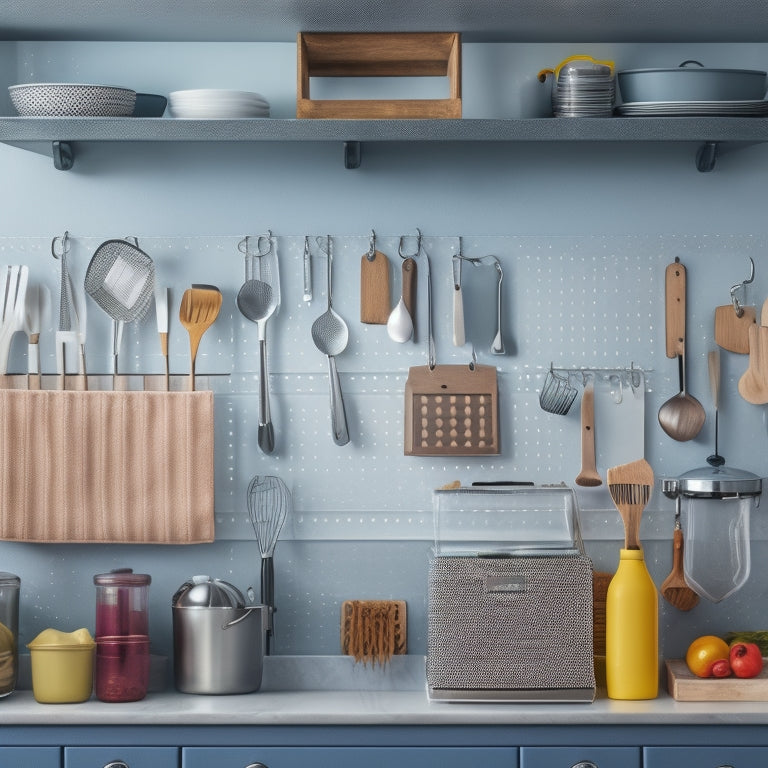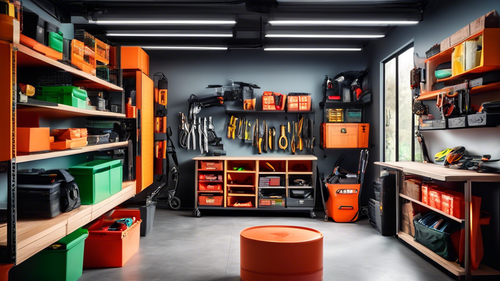
3 Essential Tips for Organizing Kitchen Utensils
Share
To achieve an organized kitchen, you'll want to start by utilizing vertical storage spaces, like shelves, racks, or hooks, to maximize your kitchen's wall space. Next, categorize and group similar items together, using drawer dividers and labels to create a system that makes sense to you. Finally, designate a home for each item, assigning a specific location for every utensil, gadget, and tool. By following these three essential tips, you'll be well on your way to a kitchen where everything has its place - and you'll likely discover even more ways to optimize your space as you go.
Key Takeaways
• Utilize vertical storage spaces by installing shelves, racks, or hooks to maximize storage capacity and keep utensils organized.
• Categorize and group similar items together, using drawer dividers and labels to facilitate easy identification and access.
• Designate a specific home for each utensil, ensuring everything has a designated spot to maintain organization and prevent clutter.
• Store frequently used items in easy-to-reach locations, reserving higher shelves for infrequently used items to optimize space.
• Implement a functional system that makes sense to you, maintaining consistency in storing items to facilitate easy access and retrieval.
Utilize Vertical Storage Spaces
How can you maximize the often-wasted vertical area in your kitchen to store utensils, freeing up countertops and drawers for more essential items? By leveraging wall space, you can significantly increase your kitchen's storage capacity without sacrificing style or functionality.
To get started, take stock of your kitchen's vertical real estate, identifying areas where you can install shelves, racks, or hooks. Maximize wall space by installing floor-to-ceiling shelves or cabinets, perfect for storing infrequently used items like special occasion dishes or cookbooks.
Next, utilize hooks to hang utensils like pots, pans, and kitchen gadgets. This not only frees up cabinet space but also keeps frequently used items within easy reach. Consider installing a pegboard on a wall or the back of a cabinet door, allowing you to hang items like colanders, utensil holders, and even bags.
Categorize and Group Similar Items
Now that you've maximized your kitchen's vertical storage capacity, it's time to categorize and group similar items together, ensuring that everything has a designated home and making it easier to find what you need when you need it.
Start by grouping similar items, such as all baking utensils or cooking tools, into categories. This will help you identify what you have and where it should be stored. Use drawer dividers to separate these categories within your drawers, keeping similar items together and preventing clutter from building up.
Implement a labeling system to identify what's inside each drawer or container, making it easy to find what you need at a glance.
For items that are better suited to hanging, such as pots and pans, utilize hanging racks to keep them organized and within reach. Container bins can be used to store smaller items like spices or oils, keeping them tidy and organized.
Designate a Home for Each Item
With your categorized groups in place, assign a specific location for each item within its designated category, ensuring that everything has a precise and consistent home. This means that each utensil, gadget, or tool will have a designated spot where it will be stored, making it easy to find and access when needed.
In your drawers, use drawer dividers to separate items and prevent clutter from building up. For example, you can have a section for baking utensils, another for cooking tools, and another for dinnerware. This will keep your drawers organized and make it easy to find what you need.
On your walls, use wall hooks to hang items like pots, pans, utensils, and even aprons. This won't only free up space in your cabinets and drawers but also add a decorative touch to your kitchen.
Frequently Asked Questions
How Often Should I Clean and Maintain My Kitchen Utensil Organization System?
You might think cleaning your kitchen utensil organization system is a chore, but setting a regular cleaning schedule and following simple maintenance tips will keep your storage solutions running smoothly, maximizing your space-saving ideas.
Can I Use Adhesive Hooks on My Kitchen Cabinets and Walls?
You can use adhesive hooks on kitchen cabinets and walls, but consider alternatives like 3M command strips or over-the-door hooks for easier removal and flexibility in your cabinet organization and wall storage solutions.
What Is the Best Way to Store Kitchen Utensils With Long Handles?
You'll maximize storage and accessibility by using a utensil holder or drawer dividers to organize kitchen utensils with long handles, or consider installing a hanging rack or wall mount to keep them within easy reach.
How Do I Organize Kitchen Utensils in a Small Kitchen With Limited Space?
In your cozy kitchen, every inch counts! You'll maximize space by implementing space-saving solutions, decluttering techniques, and vertical storage. Utilize drawer dividers to categorize utensils, freeing up precious counter real estate for a more efficient cooking experience.
Are There Any Eco-Friendly Kitchen Utensil Storage Options Available?
You'll find eco-friendly kitchen utensil storage options that fit your style, from sustainable bamboo racks to upcycled containers made from recycled materials, offering a guilt-free way to organize your kitchen essentials.
Related Posts
-

Clever Ways to Conceal Garage Clutter
Raise your hand if you have a garage full of clutter! Don't worry, you're not alone. A messy garage is a common p...
-

Transform Your Space With These DIY Hacks
You're just a few DIY hacks away from transforming your space into a stylish oasis that reflects your personality and...
-

Maximizing Space With Smart Home Gadgets
By incorporating smart home gadgets, you can efficiently maximize every inch of available space in your home. In the ...


